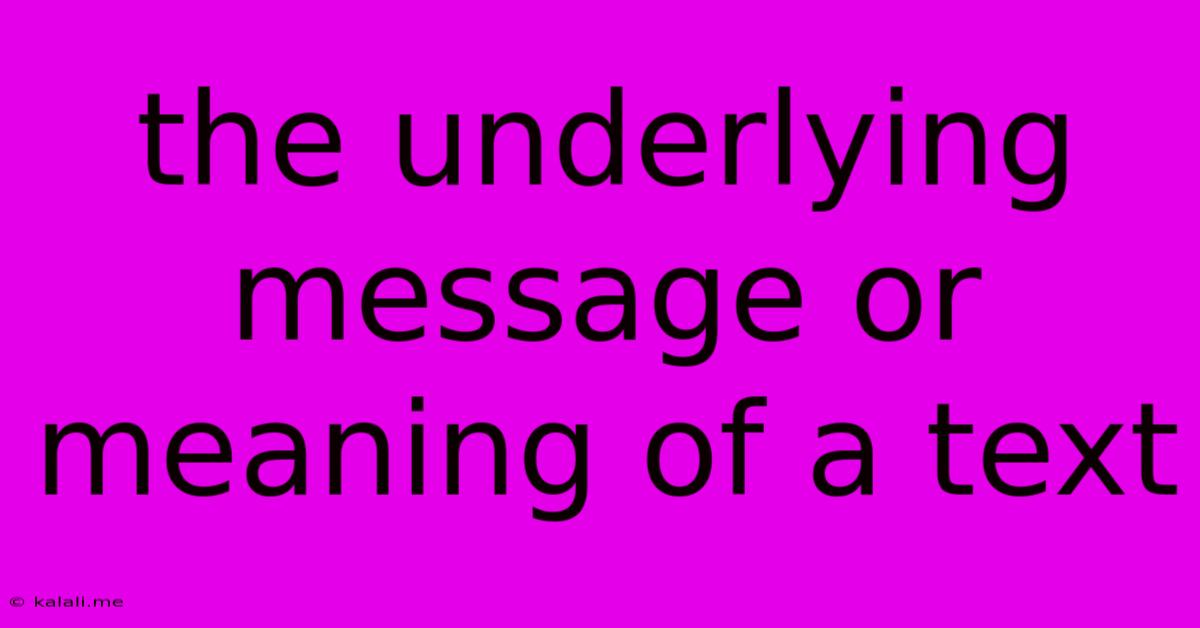The Underlying Message Or Meaning Of A Text
Kalali
May 24, 2025 · 3 min read

Table of Contents
Unearthing the Hidden Depths: Discovering the Underlying Message of a Text
Understanding the surface meaning of a text is relatively straightforward. However, truly grasping a piece of writing involves delving deeper to uncover its underlying message or meaning – the unspoken, often subtle, ideas and themes the author conveys. This process goes beyond simple comprehension and requires critical analysis, interpretation, and a keen understanding of literary techniques. This article explores how to effectively uncover the hidden depths of a text and understand its true meaning.
What is the underlying message? The underlying message, also known as the implied meaning, deeper meaning, or theme, is the central idea or concept the author is trying to communicate beyond the literal narrative. It’s the takeaway message, the core truth or insight the author wants the reader to understand. It's often not explicitly stated but rather woven throughout the text through character actions, plot developments, symbolism, and other literary devices.
Strategies for Uncovering the Underlying Message:
1. Analyze the Plot and Characters:
- Character Arcs: Pay close attention to how characters change throughout the story. Their growth, struggles, and ultimate fates often reveal the author’s message about life, morality, or human nature. Do characters overcome significant obstacles, and what do these triumphs symbolize?
- Conflicts and Resolutions: Examine the central conflicts within the text. How are these conflicts resolved? The resolution, or lack thereof, can illuminate the underlying message. Does the text offer clear-cut answers, or does it leave the reader pondering complex issues?
- Plot Structure: Consider the narrative structure itself. A non-linear plot, for example, might highlight the unpredictability of life or the fragmented nature of memory. The use of flashbacks or foreshadowing can also significantly contribute to the overall meaning.
2. Identify Literary Devices and Symbolism:
- Metaphors, Similes, and Allegories: These figurative language devices are often used to convey deeper meanings. Analyze their use and consider what abstract concepts they might represent.
- Symbolism: Many texts employ symbols – objects, characters, or events that represent something beyond their literal meaning. Identifying and interpreting these symbols is crucial for understanding the underlying message. For example, a recurring image of a bird might symbolize freedom or escape.
- Irony and Satire: The use of irony and satire can powerfully highlight societal issues or critique human behavior, providing insight into the author's intended message.
3. Consider the Context:
- Historical Context: Understanding the time period and cultural context in which the text was written can shed light on its underlying message. What were the dominant social, political, or economic issues of the time?
- Author's Background: Knowing something about the author's life and beliefs can provide valuable context for interpreting their work. However, avoid making assumptions; focus on how the author's background informs the text, not the other way around.
- Genre Conventions: The genre of the text (novel, poem, play, etc.) influences its interpretation. Consider the typical themes and conventions associated with that genre.
4. Engage in Critical Discussion:
- Multiple Interpretations: Remember that literary works can have multiple valid interpretations. Different readers may focus on different aspects and come to different conclusions.
- Supporting Evidence: Always support your interpretations with evidence from the text itself, quoting specific passages and explaining how they relate to your understanding of the underlying message.
- Reflective Reading: Allow yourself to reflect on your own personal responses and connections to the text. This personal engagement can enrich your understanding and lead to a more insightful interpretation.
By employing these strategies, you can move beyond surface-level understanding and uncover the rich layers of meaning embedded within any text. Remember, the process of interpretation is an active one, requiring careful observation, critical thinking, and a willingness to engage with the text on multiple levels. The reward is a deeper appreciation for the artistry and insight of the author's work.
Latest Posts
Latest Posts
-
What Is A 3d Rectangle Called
May 24, 2025
-
Lyrics I Am The Highway Audioslave
May 24, 2025
-
How To Jump Start A Starter
May 24, 2025
-
How Do You Get Gasoline Smell Off Hands
May 24, 2025
-
How To Remove The Rust Stains From Clothes
May 24, 2025
Related Post
Thank you for visiting our website which covers about The Underlying Message Or Meaning Of A Text . We hope the information provided has been useful to you. Feel free to contact us if you have any questions or need further assistance. See you next time and don't miss to bookmark.